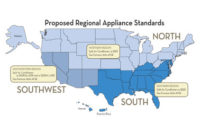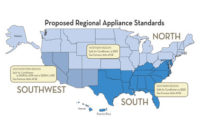The regional energy-efficiency standards dictating residential HVAC equipment have been a hot topic in the industry since — and before — a lawsuit halted the U.S. Department of Energy’s (DOE) rule in its tracks. And now, as the regional standards ruling remains entangled in litigation, it is becoming more difficult for the HVAC industry to determine how to move ahead.
The initial implementation date for the first phase of the standards, which would have raised the minimum-efficiency standards for nonweatherized furnaces, was scheduled to occur in May 2013. However, the rule was delayed and stayed due in part to a pending lawsuit. The next phase of the standards, which will mandate regional minimum-efficiency standards for air conditioners, heat pumps, and weatherized furnaces is still slated to go into effect on Jan. 1, 2015. However, due to the ongoing litigation, there is currently a swell of uncertainty surrounding this portion — and every other aspect — of the rule.
According to Karen Meyers, corporate director of government relations for Rheem Mfg. Co., “Manufacturers like Rheem are prepared for the 2015 implementation of the standards, and we are trying to serve as effective resources for our customers to answer any questions that they have about what to expect next year. That said, the uncertainty that arises out of ongoing litigation makes it very difficult for us to properly educate our customers about what’s ahead in the future.”
She continued, “Dealers, for instance, are unsure about the enforcement surrounding regional standards as it has never been defined. Unfortunately, not knowing the fate of the standards means we can’t help our customers address their most significant concerns until litigation is resolved.”
Prepare for Standards to Take Effect
Despite the uncertain environment, the common-sense advice offered by many experts is for the industry to continue to act as though the 2015 standards will be implemented on Jan. 1, 2015.
“At this point, the standards are still the law and will go into effect Jan. 1, 2015,” said Bryan Rocky, director, residential product management, unitary products, Johnson Controls. “That’s not to say that the law can’t be changed as a result of ongoing litigation working its way through the courts. But until that happens, we have to make plans based on the law as it is currently written, published, and scheduled.”
Further describing his company’s approach, Rocky said that Johnson Controls is proceeding with plans to redesign some existing products and introduce new products that will meet the efficiency requirements as outlined in the 2015 standards.
“In the event of litigation, a revision, or a delay in the enactment of the new standards, we have products that we can continue to sell. We remain prepared to introduce several new products,” he said.
Similarly, Carrier is tracking the lawsuit and assuming the new standards will take effect in 2015, according to John Gibbons, director of residential product and platform strategy.
“We are keeping a close watch on the process through our relationships with AHRI [Air-Conditioning, Heating, and Refrigeration Institute], ACCA [Air Conditioning Contractors of America], and HARDI [Heating, Air-conditioning, Refrigeration Distributors International], as well as other industry affiliations to stay abreast of developments in the APGA [American Public Gas Association] lawsuit and the impact on all products for 2015. Carrier supports a resolution that is fair for all parties,” Gibbons said. “With that being said, we still have to plan accordingly and assume that the new cooling standards will go into effect as currently scheduled on Jan. 1, 2015.”
Charlie McCrudden, senior vice president of government relations for ACCA, said he is telling his association’s members to prepare for all possible resolutions to the lawsuit. “The best advice we can provide our members is to be prepared for one of several possible outcomes: either the furnace rules are vacated and the central a/c rules remain in place; furnace and a/c rules are struck down; or the furnace rules and a/c rules are upheld,” he said.
Overall, McCrudden said, “The best recommendation is to assume the current situation [furnace rules vacated; central a/c standards set to go into effect] when planning or bidding jobs. If somehow the furnace rules were to be reinstated, there is a six-month delay in their enforcement under the court’s May 1 vacatur order.”
Contractor and Consumer Education
Frank Landwehr, vice president, air conditioning marketing, Emerson Climate Technologies, agreed that contractors need to be ready to implement the new standards, but expressed concern about the current level of contractor education on this subject.
“There is evidence that many contractors are not prepared to address these changes with homeowners. In a contractor survey conducted by Emerson in late 2013, 74 percent of contractors were either unaware of the standards or had little idea how the standards would affect their businesses. Approximately 12 percent had started training their technicians or thinking about an inventory plan,” he said.
Landwehr offered a brief summary of what contractors should be up to speed on before the standards become effective.
“Contractors will need to be familiar with all the new OEM equipment offerings and be prepared to answer questions about the best solutions for their customers, especially those in the South and Southwest where they will have to comply with higher SEER minimums,” he said. “There will also be further confusion about the tradeoffs associated with partial system replacements versus a complete system upgrade, so contractors should have these facts available when they are asked.”
Gibbons recommended that contractors educate their sales teams on the standards.
“I’d recommend something similar to what was done for the 13 SEER-efficiency and R-410A-refrigerant transitions,” he said. “Professional contractors should provide sales personnel with talking points addressing the background, timing, and requirements of the standards, so they are equipped to explain the logic behind the changes to the end user.”
Meyers added a word of caution, noting that the ongoing litigation makes it challenging for contractors to communicate with customers the potential impact of the 2015 standards. “With so much uncertainty about the 2015 standards, it could be very confusing for manufacturers, distributors, and contractors to begin engaging consumers in conversations about the 2015 standards. Right now, we do not know the level of responsibility that each party in the supply chain will have regarding compliance and enforcement of the standards. The challenges of managing inventory in accordance with the standards are also concerning to the industry. Until litigation is resolved, and we have concrete feedback from the DOE about what’s ahead, the industry can’t confidently give guidance to homeowners about what to expect next year,” she said.
Because of this, the education and communication needed for contractors and consumers will evolve throughout 2014 as the standards continue their way through the court process.
“This is going to be an interesting discussion that we will initiate with our contractors through our distribution channel throughout the year,” Rocky said. “At this point, all we can tell them is that this is the law, this is the best information we have, and here is what you can and cannot do relative to systems and components. We’ll try to make the message as clear as we can, and provide as much information as we can.”
Unclear Consequences
Another cause for concern surrounding the upcoming 2015 standards is that enforcement is still a great unknown.
“Should the regional energy-efficiency standards for central air conditioners remain in place, the bigger concern for ACCA members is how they will be enforced,” McCrudden said. “The regional standards scheme for residential central air conditioners is complicated by the fact that it’s broken down into three regions, with one of the regions (the Southwestern) including a second metric (minimum EER) and size component. The DOE has made almost no progress in developing an enforcement plan and we are very concerned that it may not be finalized until a few months or weeks before the new standards take effect on Jan. 1, 2015.”
McCrudden noted that DOE released a framework document that included three proposed enforcement methods in December 2011, but the rulemaking is still open.
“Two of the approaches would place new recordkeeping and information-disclosure requirements on contractors, including information that most contractors consider confidential business information,” said McCrudden.
ACCA has argued that an enforcement plan must protect legitimate contractors from those who may sell equipment that does not meet the regional standard, but without any unnecessary or costly compliance requirements.
Rocky also expressed concern about the unknowns for distributors and contractors.
“Because the DOE has not published the final enforcement policy, we do not know how DOE will handle enforcement of the standards. We anticipate DOE is going to hold contractors responsible,” he said. “Contractors are going to have to know what products can be installed in what locations and what cannot be sold based on where the customer is located. In addition, contractors will need to consider the impact of the new standards on certain products, based on the products’ date of manufacture, and in other cases, the date of installation. This will lead to a certain amount of confusion.”
To further illustrate this, Rocky described a specific troublesome scenario that could take place.
“For example, a contractor in California, where the standard for air conditioners moves to 14 SEER on Jan. 1, 2015, will not be able to install any 13 SEER units, even if they were manufactured or purchased before the standard went into effect. This is because the air conditioner requirements are based on date of installation. However, that is not the case for heat pumps, which are considered to be a national standard. So the same contractor could sell and install any 13 SEER heat pump that exists in the inventory channel prior to Jan. 1, 2015. Even though the law requires 14 SEER heat pumps in 2015, as a national standard, that allows contractors to sell their existing inventory, even if SEER ratings are lower than the new standard,” he said.
He continued, noting the potential impact the standard could have on distributors. “How our distribution partners manage that situation will be really interesting, especially when some of their locations can sell inventory and some of them cannot. Undoubtedly, contractors will face the biggest changes, and they will need to know what they can sell and how the new standards will be enforced,” Rocky said.
Meyers noted that manufacturers are also concerned about how enforcement will occur at every level of the supply chain.
“If the standards stay intact, the industry needs immediate clarification on the roles that manufacturers, distributors, and contractors will have in enforcing the rule. To date, there has been little-to-no clarification about where the enforcement of the standards lies, but all parties are expecting added recordkeeping, paperwork, and reporting,” she said.
Meyers added, “At the manufacturer level, we know that we will have to update the Energy Guide labels to note where units can be sold and where they cannot be sold. However, all parties are unclear about what information we will be required to submit to the DOE and who will be responsible for submitting what.”
With so many unknowns ahead, it will be vital for contractors to stay informed and maintain communication with distributors and manufacturers. “We will communicate what we know as things progress,” Rocky said.
Publication date: 2/10/2014
Want more HVAC industry news and information? Join The NEWS on Facebook, Twitter, and LinkedIn today!









